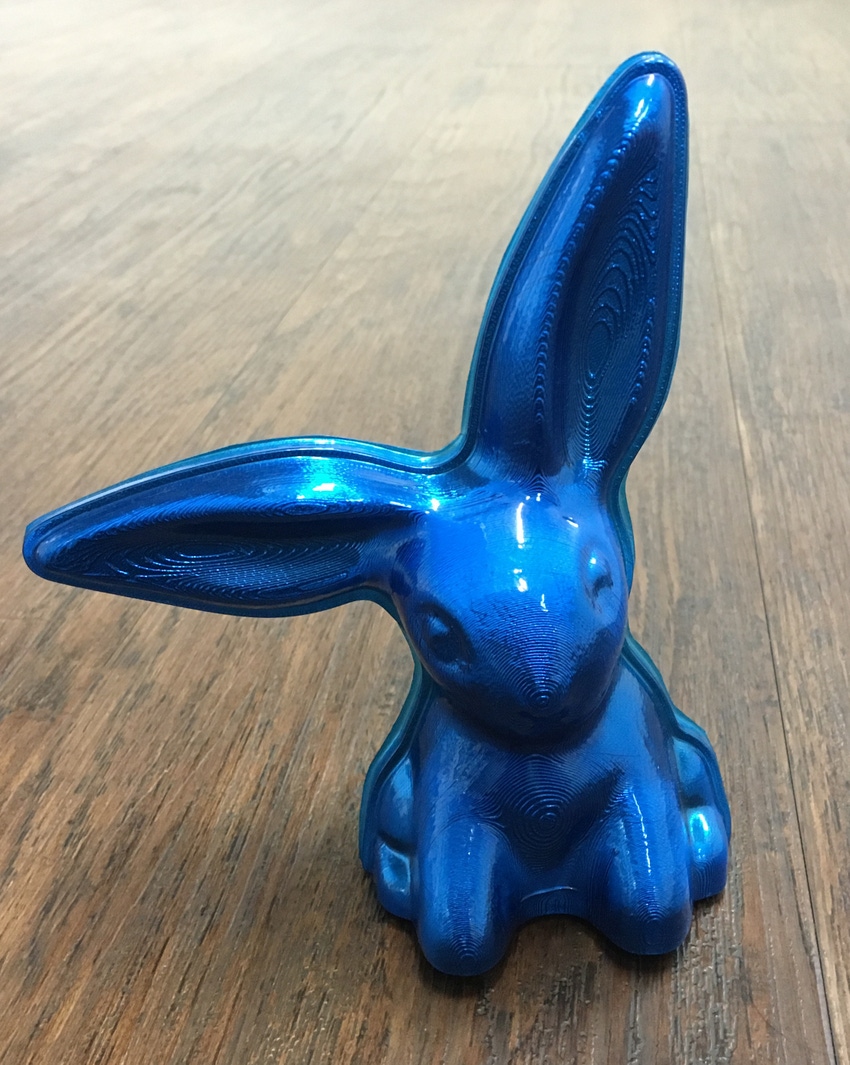Bachmann Forming AG (Hochdorf, Switzerland) uses cost-saving 3D-scanning to create fast and accurate molds for packaging used for chocolate Easter bunnies.

Consumers love sweets, and there’s no better time than the holidays to express those feelings. Think about all those chocolates and other sweets beautifully packaged for maximum impact.
One company uses 3D scanners to optimize the molds for confectionery packaging for an Easter holiday classic: chocolate bunnies.
These aren’t your standard holiday bunnies, but 3-D bunnies with oversized ears that sit poised and wrapped in form-fitting blue plastic packaging.
The company, Bachmann Forming AG (Hochdorf, Switzerland), part of the Swiss family-owned company Bachman headquartered near Lucerne, produces high-quality, to-spec packaging solutions.
In order to make their workflow more effective, Bachmann Forming AG now uses 3D scanners from Artec 3D (Luxembourg), which they bought from 3D Model AG (Zurich, Switzerland), Artec’s official reseller, which also provided them with full training.
“It has never been so easy to get the shape of an object. We are very pleased that, with our support, our customer Bachmann Forming can now streamline and speed up their work process” says Christiane Fimpel of 3D Model.
3D scanners replace tedious manual work
How do you make the best packaging for a modern chocolate rabbit? As in the past, you need to create a master form, or pilot tool that has an identical shape to the chocolate bunny provided by the manufacturer.
 Until about 10 years ago, most of the original models were handcrafted, manually ground, cast with epoxy resin or milled from wood—a process that could take up to 20 hours, depending on the product. In recent years, however, this procedure has changed dramatically with digitization. Pilot tools are now designed using computer-aided design (CAD) and manufactured from blocks of polyurethane on CNC-controlled milling machines. The block material is easy to process and guarantees a homogeneous surface.
Until about 10 years ago, most of the original models were handcrafted, manually ground, cast with epoxy resin or milled from wood—a process that could take up to 20 hours, depending on the product. In recent years, however, this procedure has changed dramatically with digitization. Pilot tools are now designed using computer-aided design (CAD) and manufactured from blocks of polyurethane on CNC-controlled milling machines. The block material is easy to process and guarantees a homogeneous surface.
Bachmann Forming was looking for a way to digitize hand-made shapes fast and with high precision, which would be especially beneficial for food packaging, since food is usually produced without CAD data versus other parts.
Marker-free scanning
Bachmann Forming then came across Artec 3D scanners. Notably, Artec scanners capture data without the need for extra orientation points. Artec Space Spider digitally captures objects that are too complex and time consuming to be measured by hand.
"We were impressed by the easy usability, and the geometry and texture-based tracking of Artec Space Spider," says Jörg Nussbaum, design engineer at Bachmann. "Capturing color also makes it easy to create photorealistic visualizations in the design phase." 
One of the key advantages of Artec’s devices is that, in contrast to other 3D scanners, they do not need adhesive markers to be stuck over the object for the scanner to maintain tracking and to align scans, since the algorithms in the software analyze both the geometry and the color data of the object.
"It would be pretty hard to stick something on a chocolate or pralines," says Nussbaum.
By using Artec’s technology to create a CAD model of the original chocolate bunny, Bachmann Forming is now able to take advantage of the expedited process of CNC machining the master form. It also has the added benefit of being less prone to manual error by eliminating hand measurement and machining.
It took Bachmann just one hour to complete the entire process.
"It's fun to see how quickly complicated shapes can find their way from hand to screen,” Nussbaum points out. “Being able to use a 3D scanner in-house is an immense time advantage. The simple usability is a winning factor—we are very satisfied with the results.”
EastPack 2018 held June 12-14 in New York City features the latest in manufacturing and automation, a dedicated 3D Printing Zone, hundreds of exhibitors and a jam-packed 3-day packaging conference. For more information, visit the EastPack website. |
Scanning is as easy as using a video camera
Andrei Vakulenko, chief business development officer at Artec 3D, provides PlasticsToday a step-by-step walk through the process.
1. Imagine the scanner is like a video camera and you’re trying to record all the sides of the object. You move the scanner smoothly around the object, capturing all surfaces. If necessary, you can take separate scans of the bottom of the object, or of different sides, if the object is too big to capture in one go. 
2. The easiest way to process it would be to select the scan, or multiple scans, and run them through the autopilot mode of the Artec Studio software. Autopilot analyses your data and automatically processes it, applying the most appropriate algorithms to your set of data.
The time it takes to scan and process depends on the size and complexity of the object. This is a 3D model of our scanner Artec Eva, which we digitized using our Artec Space Spider scanner.
Vakulenko says the above example took about four minutes for the 3D scan and 10 minutes to process the data.
Asked about file formats, he responds that "users can export from Artec Studio and from Artec Studio all popular 3D formats, including OBJ, PLY and STL."
The end result
The final packaging for the bunnies are thermoforms from plastic sheet. It's such a perfect fit that the packaging looks as if it were second, blue skin.
"Before we had Space Spider, this kind of work had to be outsourced, which was very time-consuming and cost-intensive," explains Nussbaum. "The external service provider scanned the chocolate bunny as it was, with all the details, so the 3D model also showed all the bumps that were in the chocolate. Now we can immediately intervene in the data processing stage and delete these parts."
Nussbaum also likes the time advantage—scanning by external companies can take up to two weeks.
"When we do it ourselves we scan whenever we have time," he says. "In the packaging business you have to be fast and innovative. With Artec Space Spider we have found a tool that will help us with many upcoming projects."
This kind of 3D scanning application is now fairly standard, Vakulenko tells PlasticsToday. “Our scanners are quite commonly used by plastic molders, both for creating new molds and for quality control of existing ones.”
There are also other ways in which the technology can be used to right-size packaging.
“With our scanners you can easily and quickly capture the exact shape of an object and then create packaging which fits it exactly, without wasting extra material,” Vakulenko says. “Customers can also set up an automatic inspection line, using the scanners to check the condition of used packaging, with the idea to reuse material that is still in good shape.”
Please take our instant one-question poll about 3D scanning.
About the Author(s)
You May Also Like




